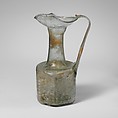Glass hexagonal jug with Jewish symbols
Translucent light green; handle in same color.
Mouth and neck free blown. Rounded, partially tubular rim, folded out and down; broad trefoil mouth with narrowed spout; cylindrical neck with bulge at top, then expanding downwards; concave shoulder with rounded outer edge; hexagonal body with concave sides; pushed-in bottom with small central kick and circular pontil scar; broad strap handle applied in uneven pad to top of body and edge of shoulder, drawn up and outwards in a straight line, then curved in and trailed off on rim opposite spout with slight upward trail folded back on top of handle.
On the body, six rectangular panels with impressed decoration, each of a different design bordered by lines of recessed dots. They comprise a five-branched menorah on a tripod base, a double lozenge with diamond-shaped central boss, and various vegetal motifs, including a stylized palm tree.
Complete, but crack across middle of handle; pinprick and elongated bubbles, with some black impurities in handle and rim; dulling, slight pitting, and faint whitish iridescent weathering, with patches of thicker creamy brown weathering on interior of neck and handle.
Such hexagonal and octagonal jars or jugs were mass-produced in molds for the pilgrim trade in the Holy Land. This example, found in Cyprus, bears witness to the important place the island had on the sea route that brought pilgrims to Jerusalem.
Due to rights restrictions, this image cannot be enlarged, viewed at full screen, or downloaded.

